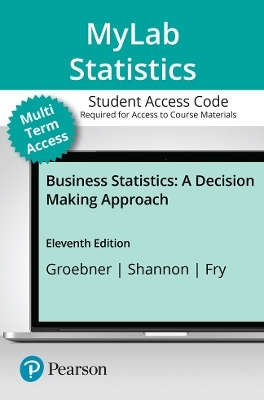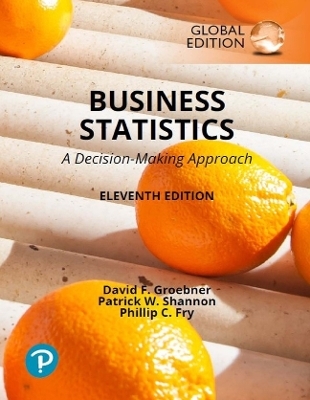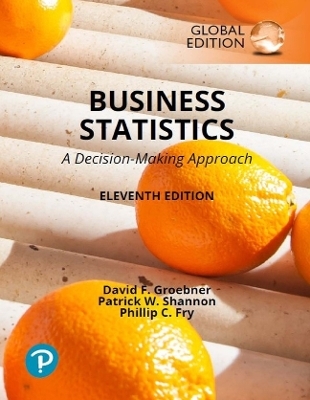
MyLab Statistics with Pearson eText (up to 24 months) Access Code for Business Statistics
Pearson (Hersteller)
978-0-13-807858-4 (ISBN)
- Titel nicht im Sortiment
- Artikel merken
Personalize learning with MyLab Statistics with Pearson+ eTextbook This flexible digital platform combines unrivaled content, online assessments and customizable features to personalize learning and improve results.
Pearson+ eTextbook is an easy-to-use digital textbook available within MyLab® that lets you read, highlight and take notes, all in one place.
NOTE: Before purchasing, check with your instructor to confirm the correct ISBN. Several versions of the MyLab and Mastering® platforms exist for each title, and registrations are not transferable. To register for and use MyLab, you will need either a course ID from your instructor or an invitation link that your instructor will send you directly.
Used books, rentals, and purchases made outside of Pearson If purchasing or renting from companies other than Pearson, the access codes for the MyLab platform may not be included, may be incorrect, or may be previously redeemed. Check with the seller before completing your purchase.
About our authors David F. Groebner, PhD is Professor Emeritus of Production Management in the College of Business and Economics at Boise State University. He has bachelor's and master's degrees in engineering and a PhD in business administration. After working as an engineer, he has taught statistics and related subjects for 27 years. In addition to writing textbooks and academic papers, he has worked extensively with both small and large organizations including Hewlett-Packard, Boise Cascade, Albertson's and Ore-Ida. He has also consulted for numerous government agencies, including Boise City and the U.S. Air Force. Patrick W. Shannon, PhD is Professor and Dean Emeritus of Supply Chain Operations Management in the College of Business and Economics at Boise State University. He has taught graduate and undergraduate courses in business statistics, quality management and lean operations, and supply chain management. Dr. Shannon has lectured and consulted in the statistical analysis and lean/quality management areas for more than 30 years. Among his consulting clients are Boise Cascade Corporation, Hewlett-Packard, PowerBar, Inc., Potlatch Corporation, Woodgrain Millwork, Inc., J.R. Simplot Company, Zilog Corporation, and numerous other public- and private-sector organizations. Professor Shannon has co-authored several university-level textbooks and has published numerous articles in such journals as Business Horizons, Interfaces, Journal of Simulation, Journal of Production and Inventory Control, Quality Progress, Journal of Marketing Research, and Decision Sciences Journal of Innovative Education. He obtained BS and MS degrees from the University of Montana, and a PhD in statistics and quantitative methods from the University of Oregon. Phillip C. Fry, PhD is a professor Emeritus of Supply Chain Management in the College of Business and Economics at Boise State. Phil received his BA and MBA degrees from the University of Arkansas and his MS and PhD degrees from Louisiana State University. His teaching and research interests are in the areas of business statistics, supply chain management, and quantitative business modeling. He has published in the European Journal of Operations Research, Production and Inventory Management Journal, Journal of Accounting and Finance, Journal of the Academy of Finance, and the Decision Sciences Journal of Innovative Education. In addition to his academic responsibilities, Phil has consulted with and provided training to small and large organizations, including Boise Cascade Corporation, Hewlett-Packard Corporation, the J.R. Simplot Company, United Water of Idaho, Woodgrain Millwork, Inc., Boise City, and Intermountain Gas Company.
1. The Where, Why, and How of Data
2. Graphs, Charts, and Tables: Describing Your Data
3. Describing Data Using Numerical Measures
1 - 3 SPECIAL REVIEW SECTION
4. Introduction to Probability
5. Discrete Probability Distributions
6. Introduction to Continuous Probability Distributions
7. Introduction to Sampling Distributions
8. Estimating Single Population Parameters
9. Introduction to Hypothesis Testing
10. Estimation and Hypothesis Testing for Two Population Parameters
11. Hypothesis Tests and Estimation for Population Variances
12. Analysis of Variance
8 - 12 SPECIAL REVIEW SECTION
13. Goodness-of-Fit Tests and Contingency Analysis
14. Introduction to Linear Regression and Correlation Analysis
15. Multiple Regression Analysis and Model Building
16. Analyzing and Forecasting Time-Series Data
17. Introduction to Nonparametric Statistics
18. Introducing Business Analytics
19. Introduction to Decision Analysis (Online)
20. Introduction to Quality and Statistical Process Control (Online)
APPENDICES
A. Random Numbers Table
B. Cumulative Binomial Distribution Table
C. Cumulative Poisson Probability Distribution
D. Standard Normal Distribution Table
E. Exponential Distribution Table
F. Values of t for Selected Probabilities
G. Values of χ2 for Selected Probabilities
H. F-Distribution
I. Distribution of the Studentized Range (q-values)
J. Critical Values of r in the Runs Test
K. Mann - Whitney U Test Probabilities (n < 9)
L. Mann - Whitney U Test Critical Values (9 ≤ n ≤ 20)
M. Critical Values of T in the Wilcoxon Matched-Pairs Signed-Ranks Test (n ≤ 25)
N. Critical Values dL and dU of the Durbin-Watson Statistic D
O. Lower and Upper Critical Values W of Wilcoxon Signed-Ranks Test
P. Control Chart Factors
| Erscheint lt. Verlag | 14.7.2023 |
|---|---|
| Sprache | englisch |
| Themenwelt | Wirtschaft ► Volkswirtschaftslehre ► Ökonometrie |
| ISBN-10 | 0-13-807858-0 / 0138078580 |
| ISBN-13 | 978-0-13-807858-4 / 9780138078584 |
| Zustand | Neuware |
| Haben Sie eine Frage zum Produkt? |
aus dem Bereich

